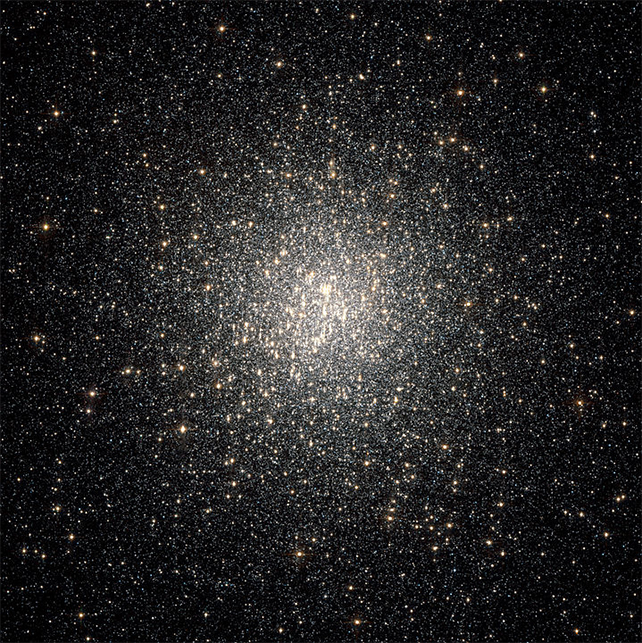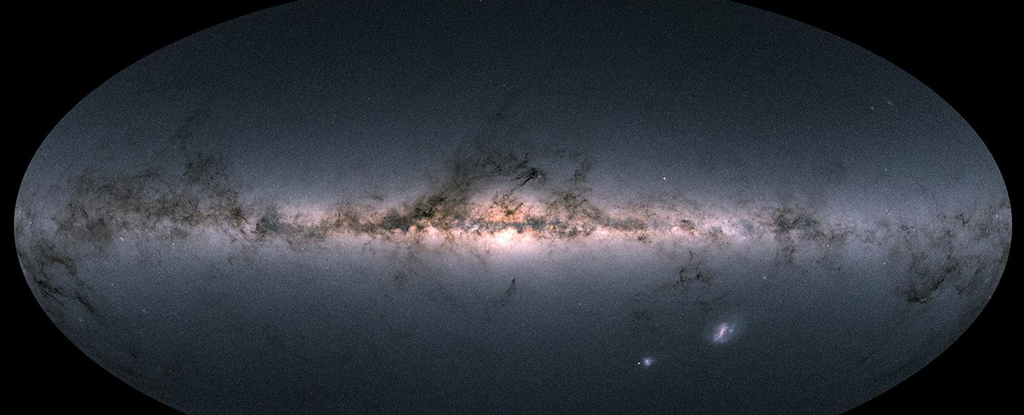Products You May Like
The Milky Way is only as massive as it is because of collisions and mergers with other galaxies. This is a messy process, and we see the same thing happening with other galaxies throughout the Universe.
Currently, we see the Milky Way nibbling at its two satellite galaxies, the Large and Small Magellanic Clouds. Their fate is likely sealed, and they’ll be absorbed into our galaxy.
Researchers thought the last major merger occurred in the Milky Way’s distant past, between 8 and 11 billion years ago. But new research amplifies the idea that it was much more recent: less than 3 billion years ago.

This new insight into our galactic history comes from the ESA’s Gaia mission. Launched in 2013, Gaia is busily mapping 1 billion astronomical objects, mostly stars. It measures them repeatedly, establishing accurate measurements of their positions and motions.
A new paper published in the Monthly Notices of the Royal Astronomical Society presents the findings. It’s titled “The Debris of the ‘Last Major Merger’ is Dynamically Young.” The lead author is Thomas Donlon, a post-doctoral researcher in Physics and Astronomy at the University of Alabama, Huntsville. Donlon has been studying mergers in the Milky Way for several years and has published other work on the matter.
Each time another galaxy collides and merges with the Milky Way, it leaves wrinkles. ‘Wrinkles’ obviously isn’t a scientific term. It’s an umbrella term for several types of morphologies, including phase space folds, caustics, chevrons, and shells.
These wrinkles move through different groups of stars within the Milky Way, affecting how the stars move through space. By measuring the positions and velocities of these stars with great precision, Gaia can detect the wrinkles, the imprint of the last major merger.
“We get wrinklier as we age, but our work reveals that the opposite is true for the Milky Way. It’s a sort of cosmic Benjamin Button, getting less wrinkly over time,” said lead author Donlon in a press release.
“By looking at how these wrinkles dissipate over time, we can trace when the Milky Way experienced its last big crash – and it turns out this happened billions of years later than we thought.”
The effort to understand the Milky Way’s (MW) last major merger involves different pieces of evidence. One of the pieces of evidence, along with wrinkles, is an Fe/H-rich region where stars follow a highly eccentric orbit.
A star’s Fe/H ratio is a chemical fingerprint, and when astronomers find a group of stars with the same fingerprint and the same orbits, it’s evidence of a common origin. This group of stars is sometimes called ‘the Splash.’ The stars in the Splash may have originated in a Fe/H-rich progenitor. They have odd orbits that stand out from their surroundings. Astronomers think they were heated and their orbits altered as a by-product of the merger.
There are two competing explanations for all of the merger evidence.
One says that a progenitor dwarf galaxy named Gaia Sausage/Enceladus (GSE) collided with the MW proto-disk between 8 and 11 billion years ago. The other explanation is that an event called the Virgo Radial Merger (VRM) is responsible for the stars in the inner halo. That collision occurred much more recently, less than 3 billion years ago.
“These two scenarios make different predictions about observable structure in local phase space because the morphology of debris depends on how long it has had to phase mix,” the authors explain in their paper.
The wrinkles in the MW were first identified in Gaia data in 2018 and presented in this paper.
“We have observed shapes with different morphologies, such as a spiral similar to a snail’s shell. The existence of these substructures has been observed for the first time thanks to the unprecedented precision of the data brought by Gaia satellite, from the European Space Agency (ESA)”, said Teresa Antoja, the study’s first author, in 2018.
But Gaia has released more data since 2018, and it supports the more recent merger scenario, the Virgo Radial Merger. That data shows that the wrinkles are much more prevalent than the earlier data and the studies based on it suggest.
“For the wrinkles of stars to be as clear as they appear in Gaia data, they must have joined us less than 3 billion years ago – at least 5 billion years later than was previously thought,” said co-author Heidi Jo Newberg, from the Rensselaer Polytechnic Institute.
If the wrinkles were much older and conformed to the GSE merger scenario, they’d be more difficult to discern.
“New wrinkles of stars form each time the stars swing back and forth through the center of the Milky Way. If they’d joined us 8 billion years ago, there would be so many wrinkles right next to each other that we would no longer see them as separate features,” Newberg said.
This doesn’t mean there’s no evidence for the more ancient GSE merger. Some of the stars that hint at the ancient merger may be from the more recent VRM merger, and some may still be associated with the GSE merger.
It’s challenging to figure out, and simulations play a large role. The researchers in previous work and in this work ran multiple simulations to see how they matched the evidence.
“Our goal is to determine the time that has passed since the progenitor of the local phase-space folds collided with the MW disc,” the authors write in their paper.
“We can see how the shapes and number of wrinkles change over time using these simulated mergers. This lets us pinpoint the exact time when the simulation best matches what we see in real Gaia data of the Milky Way today – a method we used in this new study too,” said Thomas.
“By doing this, we found that the wrinkles were likely caused by a dwarf galaxy colliding with the Milky Way around 2.7 billion years ago. We named this event the Virgo Radial Merger.” Those results and the name come from a previous study from 2019.
As Gaia delivers more data with each release, astronomers are getting a better look at the evidence of mergers. It’s becoming clear that the MW has a complex history.
The VRM likely involved more than one entity. It could have brought a whole group of dwarf galaxies and star clusters into the MW at around the same time. As astronomers research the MW’s merger history in greater detail, they hope to determine which of these objects are from the more recent VRM and which are from the ancient GSE.
“The Milky Way’s history is constantly being rewritten at the moment, in no small part thanks to new data from Gaia,” adds Thomas. “Our picture of the Milky Way’s past has changed dramatically from even a decade ago, and I think our understanding of these mergers will continue to change rapidly.”
“This finding improves what we know of the many complicated events that shaped the Milky Way, helping us better understand how galaxies are formed and shaped – our home galaxy in particular,” said Timo Prusti, Project Scientist for Gaia at ESA.
This article was originally published by Universe Today. Read the original article.
